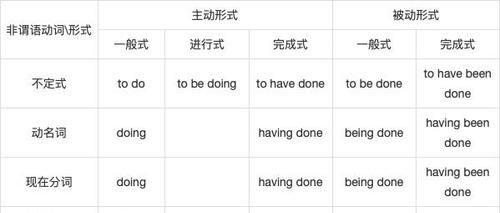本文目录
非谓语动词的用法总结
非谓语动词是历年的 热点 、难点和重点。在学习非谓语动词时,好多同学感到"剪不断,理还乱"。所以在复习中,非常有必要通过观察、比较,归纳掌握其用法,并 总结 其用法。下面是我整理的非谓语动词用法总结大全,希望对大家的 英语学习 有所帮助。
最全面的非谓语动词用法总结
1 .不定式和动名词作主语的区别
(1)动名词作主语通常表示抽象动作;而不定式作主语表示具体动作。
Smoking is prohibited(禁止)here.这里禁止抽烟。(抽象)
It is not very good for you to smoke so much.你抽这么多烟对你身体很不好。(具体)
(2)动名词作主语时,通常用以表示一件已知的事或 经验 。
不定式 短语 通常用来表示一件未完成的事或目的。
Climbing mountains is interesting.爬山很有趣。(经验)
Driving a car during the rush hour is tiring.在高峰时刻开车令人厌烦。(经验)
(3)不定式做主语,一般用it当形式主语,把作主语的不定式短语后置。
It took me only five minutes to finish the job.
2 .不定式、动名词和分词作表语的区别
(1)不定式作表语
1)不定式作表语一般表示具体动作,特别是表示将来的动作。
To do two things at a time is to do neither.--次做两件事等于未做。
What I would suggest is to start work at once.我的建议是立刻开始干。
2)如果主语是不定式(表示条件),表语也是不定式(表示结果)。
To see is to believe.百闻不如一见。
To work means to earn a living.工作就是为了生活。
3)如果主语是以aim,duty,hope,idea,happiness,job,plan,problem,purpose,thing,wish等为中心的名词,或以what引导的名词性从句,不定式作表语是对主语起补充说明作用。
His wish is to buy a luxurious car in the near future.他的希望是在不远的将来买一辆豪华轿车。
The function of Louis Sullivan's architecture was to provide large uninterrupted floor areas and to allow ample light into the interior.
The most important thing is to negotiate with them about the future of the plant.
(2)动名词作表语:动名词作表语,表示抽象的一般性的行为。
Our work is serving the people.我们的工作是为人民服务。
His hobby is collecting stamps.他的 爱好 是 集邮 。
注:动名词作表语时与进行时态中的现在分词形式相同,但其所属结构迥异,进行时态说明动作是由主语完成的。动名词做表语,说明主语的性质或情况。
People cannot but feel puzzled,for they simply cannot understand how he could have made such a stupid mistake.
His victory in the final was no more convincing than I had expected.
(3)分词作表语
分词做表语有两种情况,一种是现在分词做表语,一种是过去分词做表语,这两者区别是考试中经常考到的地方。一般来说,表示心理状态的动词如excite,interest等都是及物动词,汉语意思不是“激动”,“高兴”,而是“使激动”、“使高兴”,因而现在分词应该是“令人激动的”、“令人高兴的”,过去分词则是“感到激动的”和“感到高兴的”。所以,凡表示“令人……的”都是-ing形式,凡是表示“感到……”都用-ed形式。换句话说,若人对……感兴趣,就是somebody is interested in...,若人/物本身有兴趣时,就是说sb./sth. is interesting.
这类词常见的有:
interesting使人感到高兴--interested感到高兴的
exciting令人激动的--excited感到激动的
delighting令人高兴的--delighted感到高兴的
disappointing令人失望的--disappointed感到失望的
encouraging令人鼓舞的--encouraged感到鼓舞的
pleasing令人愉快的--pleased感到愉快的
puzzling令人费解的--puzzled感到费解的
satisfying令人满意的---satisfied感到满意的
worrying令人担心的--worried感到担心的
Travelling is interesting but tiring.旅行是有趣的,但是使人疲劳。
The pupils will get confused if they are made to learn too much.如果要学生学得太多,他们会感到糊涂的。
The argument is very convincing.他的论点很令人信服。
They were very excited at the news.听到这个消息,他们非常激动。
3 .不定式和动名词作宾语的区别
英语中大多数动词既可跟不定式,也可跟动名词作直接宾语,但有些动词要求:
(1)不定式做宾语和宾语补足语
1)下面的动词要求不定式做宾语
attempt企图enable能够neglect忽视
afford负担得起demand要求long渴望
arrange安排destine注定mean意欲,打算
begin开始expect期望omit忽略,漏
appear似乎,显得determine决定manage设法
cease停止hate憎恨,厌恶pretend假装
ask问dread害怕need需要
agree同意desire愿望love爱
swear宣誓volunteer志愿wish希望
bear承受endeavor努力offer提供
beg请求fail不能plan计划
bother扰乱;烦恼forget忘记prefer喜欢,宁愿
care关心,喜欢happen碰巧prepare准备
decide决定learn学习regret抱歉,遗憾
choose选择hesitate犹豫profess表明
claim要求hope希望promise承诺,允许
start开始undertake承接want想要
consent同意,赞同intend想要refuse拒绝
decide决定learn学习vow起
contrive设法,图谋incline有…倾向propose提议
seek找,寻觅try试图
2)下面的动词要求不定式做宾补:动词+宾语+动词不定式
ask要求,邀请get请,得到prompt促使
allow允许forbid禁止prefer喜欢,宁愿
announce宣布force强迫press迫使
bride 收买inspire鼓舞request请求
assist协助hate憎恶pronounce断定,表示
advise劝告exhort告诫,勉励pray请求
authorize授权,委托help帮助recommend劝告,推荐
bear容忍implore恳求remind提醒
beg请求induce引诱report 报告
compel强迫invite吸引,邀请,summon传唤
command命令intend想要,企图show 显示
drive驱赶mean意欲,打算train训练
cause引起instruct指示require要求
deserve应受leave使,让tell告诉
direct指导like喜欢tempt劝诱
entitle有资格order命令warn告诫
enable使能够need需要urge激励,力说
encourage鼓励oblige不得不want想要
condemn指责,谴责lead引起,使得teach教
entreat恳求permit允许wish希望

新概念英语非谓语动词之不定式语法讲解视频
新概念英语非谓语动词之不定式语法讲解
1.定义:具有名词、形容词及副词性质并具有时态、语态变化。

2.形式:(以do为例)
主动语态 被动语态
一般时 to do to be done
进行时 to be doing
完成时 to have done to have been done
完成进行时 to have been doing
3.用法:
(1)用作主语:
To speak good English is not easy.
or: It is not easy to speak good English.
(采用形式主语 it 以避免头重脚轻)
It took me an hour to do the work.
(2)用作宾语:
She decided to take the examination.
I hope to meet him soon.
(3)宾语补足语:
They expected us to help them.
He wants his son to study hard.
金牌重点:
不定式作宾补,如谓语动词是感官动词,使役性动词(see, hear, notice, watch, make, have, let...),则不定式符号“to”须省略,但在被动语态中不能省。
I heard them sing in the classroom.
I made her clean the room.
The girl is heard to sing an English song.
(4)用作表语:
To teach is to learn.
His job is to sell cars.
(5)用作状语,表示目的',结果:
We come to school to study English.(目的)
= in order to
I hurried to the store, only to find it closed.(结果)
(6)定语:不定式短语作定语须位于名词之后。
He asked for a piece of paper to write it on.
= to write it on the piece of paper.
The poor man has no house to live in.
= to live in the house.
Have you anything to do?
= to do anything
4.不定式的时态意义:
She seems to dance very well.(现在情况)
She seems to be dancing in the dancing hall.(正在进行)
She seems to have danced well.(过去情况)
Has was happy to have been staying with his uncle.(动作持续一段时间)
5.不定式语态:
The doctor [wrecommend]recommended[/w] him to air the room.
The doctor recommended the room to be aired.
She expects the police to find her bicycle.
She expects her bicycle to be found by the police.
She felt a bit puzzled as he had asked her such a question.
She felt a bit puzzled to have been asked such a question.
6.不定式否定形式:not to do ...
He got up early in order not to miss the train.
测试精编
1. Did you find out ________ the pie out of oven?
A. to take B. have taken C. when to take D. being taken
2. You would be irritated if you watched the mail ________ on your desk every day.
A. putting up B. to be put up C. to pile up D. pile up
3. We shall set Jim ________ the passage.
A. explaining B. explained C. to explain D. explain
4. In fact, she would rather leave for San Francisco ________ in Los Angeles.
A. tostay B. than stay C. than staying D. than have stayed
5. Madame Curies is believed ________ the radium.
A. discovering B. having discovered C. to have discovered D. to discover
(后设答案,大家不要偷看哦~(*^__^*) 嘻嘻……)
KEYS
1. C 2. D 3. C 4. B 5. C
;非谓语动词的用法
第九章:非谓语动词用法
【1.0】非限定性动词学习
【2.0】非限定性动词定义
【3.0】非限定性动词分类
【4.0】非限定性动词特点
【5.0】非限定性动词用法
【2.0】非限定性动词定义:不能在句中单独作谓语,并且没有人称和数的变化,不需要和主语保持人称和数的一致,不受主语限制的动词叫非限定性动词,也叫非谓语动词.
【3.0】非限定性动词分类:
【3.1】动词不定式(to do )
【3.2】动名词(doing )
【3.3】现在分词(doing)
【3.4】过去分词(done)
【4.0】非限定性动词特点
【4.1】不能单独在句中作谓语
【4.2】可以和助动词以及情态动词构成句子谓语
【4.3】 具有限定性动词特点。
【4.4】后面可以跟自己的宾语和状语.
【4.5】 具体有时态和语态的变化
【4.6】具有名词,形容词,副词等特点
【5.0】非限定性动词用法
【1.0】非限定性动词学习
【2.0】非限定性动词定义
【3.0】非限定性动词分类
【4.0】非限定性动词特点
【5.0】非限定性动词用法
【2.0】非限定性动词定义:不能在句中单独作谓语,并且没有人称和数的变化,不需要和主语保持人称和数的一致,不受主语限制的动词叫非限定性动词,也叫非谓语动词.
【3.0】非限定性动词分类:
【3.1】动词不定式(to do )
【3.2】动名词(doing )
【3.3】现在分词(doing)
【3.4】过去分词(done)
【4.0】非限定性动词特点
【4.1】不能单独在句中作谓语
【4.2】可以和助动词以及情态动词构成句子谓语
【4.3】 具有限定性动词特点。
【4.4】后面可以跟自己的宾语和状语.
【4.5】 具体有时态和语态的变化
【4.6】具有名词,形容词,副词等特点
【5.0】非限定性动词用法
(二):动词不定式(to do )概念及形式:
动词不定式:动词不定式属于非谓语动词其中一种,在句中无人称和数的限制,并在句中起名词;形容词;或副词作用的成分,其形式有2种;一种带不定式符号“to” ,一种不带不定式符号“to ”.
(一)作主语:相当于名词或代词的,往往用it 作形式主语替代,不定式真正主语放在句末
【1】To learn English is not easy .学英文不是容易事情
【2】To see is to believe.眼见为实
【3】It is difficult to learn Russian well .
学好俄语是很难的事情
【.4】 It is so hard for foreigners to learn Chinese
学汉语对外国人来说是非常难的
【5】It is the duty of the police to preserve public order.
警察的职责是维持公共持续
【6】It is kind of you to see me off at airport
你能在机场为我送行,真是太友好了
【7】It is necessary to make a study plan
制定一个学习计划是很有必要的
【8】It is important for students to go over their lessons after class
对学生来讲,课后复习他们功课是非常重要的
【.9】It is necessary for us to learn a foreign language
对我们来说,学一门外语是非常必要的
【10】It is possible for you to do the work
【11】To live in China is Mr.Smith’dream=It is Mr.Smith’s dream to live in China
在中国生活是史密斯的梦想
【12】To stop the work now seems impossible =It seems impossible to stop the work now
现在停止这项工作似乎是不可能的
【13】To lean out of the window is dangerous.
把身子伸出窗外是危险的。
【14】To talk with him is a great pleasure.
和他谈话是一件非常愉快的事。
【15】To die for the people is a glorious death!
为人民而死,虽死犹荣。
动词不定式短语作主语时,往往放在谓语动词的后面,而在句首用引词"作语法上的主语。上述两句即可改为:
【16】It is a great pleasure to talk with him.
和他谈话时件非常愉快的事情
【17】It is a glorious death to die for the people.
为人民而牺牲是光荣的牺牲
注意也常用"It is+形容词+动词不定式短语"这样的句型:
【18】It is necessary to make a plan for this course of study.必须订一个学习这门课程的计划。
【19】It is not difficult to learn a foreign if you spend time and effort on it. 小只要你花时间下功夫,学好一门外国语并不难。
【20】It's just impossible to see that and not weep.看见那种情景而不哭是根本不可能的。(注意weep之前省去了to,以免重复)
(备注:当动词不定式比较长时,应该用it 作形式主语,把真正作主语不定式放到句子后面;动词不定前面可以加入for somebody 或者of somebody充当其逻辑主语;其句子结构为It is +形容词/名词+ for somebody / of somebody to do something;后面可以接of 的形容词:kind,bold,brave,clever,
honest,stupid
Right,wise;后面可以接for 的形容词有easy,difficult, important,heavy, necessary,possible )
(二)动词不定式(to do )作表语:表示主语职业;职责;内容;或性质;以及主语为what引导的名词行从句,起表语也可以用不定式
【1】 This house is to let (不定式放在系动词之后)
此房子出租
【2】 Her plan is to finish the work in two months
她的计划是在2个月完成这项工作
【3】His wish is become a teacher
他的愿望是成为一个老师
【4】It is for you to decide (不定式复合结构作表语)
这个需要由你来决定
The question is for you to answer
这个问题得由你来回答
【5】Our duty is to help those children (to)find their parents
我们职责是帮助那些孩子找到他们的父母
【6】Her job is to take care of the sick people
她的工作是照顾那些病人
【7】The intention of this book is to introduce popular music
这本书的目的时介绍流行音乐
【8】my wish is to travel around the world
我的愿望是周游世界
【9】what strikes me most is to see him always busy
给我印象最深的看见他一直都很忙
【10】what made me fail is to ignore the facts
让我失败的是忽视了这些事实
【11】To learn a language is to use it
学一门语言就是要使用它
【12】To save is to produce
节约等于创造
【13】Her wish is to become an astronaut.她的愿望是成为一名宇航员。
【14】Our plan is to finish the work in two weeks.我们的计划是在两周内完成这项工作。
【15】His only desire was to be useful to the country.他唯一的愿望是做一个对国家有用的人。
(三)动词不定式(to do )作作宾语:主要是作某些特定的动词后面的宾语;需要熟练记住那些动词.
【1】 She promised to come back /return in half an hour
她答应半小时后回来
【1】He can not afford to buy a car
他买不起一辆汽车
【2】I hope to see you soon
我希望很快见到你
【3】I think it necessary to help each other
我认为相互帮助是必要的
【4】I find it impossible to get everything ready in time
我觉得及时准备一切事情是不可能的
【5】He considered it better not to go
他认为还是不去为比较好
【6】He wants to be a village school teacher in a mountain area.他要做个山村教师。
【7】Do you like to watch football matches? 你喜欢看足球赛吗?
【8】Learn to walk before you run.先学走后学跑。
【9】We decided to make changes in our plan.我们决定把计划做些修改。
(备注:能接动词不定式作宾语的动词有:agree; begin;choose;decide;hope;learn;
like;offer;pretend;Promise;refuse;start;)
want;wish;fail;plan; 当动词不定式后面带补足语时,可以用it 作形式宾语,并把真正作宾语动词不定式放在句子后面;不定式作宾语后可以接补语的动词有:feel,find,judge,make,think,believe,consider )
(四)动词不定式(to do )作宾语补足语(不定式复合结构):主要是接特定动词后面做宾语补足语有些接“to ”不定式有些接不带“to ”不定式
【1】I want him to come 我想他来
【2】We consider him to be a good teacher
我们认为他是一个好老师
(备注:不定式可以和名词及代词构动词成复合结构;这样动词有:ask,tell, invite,allow,force,compel, oblige,help, wish,permit,want,like,prefer, expect,advise,persuade,
order ,urge,command,get.)
【3】I will get someone to repair the computer for you.
我们将会安排人为你修理那台电脑
【4】May I invite you to be present at the meeting?
我可以邀请你出席这场会议吗?
【5】The burglar forced this man to open his safe with gun
这个窃贼用枪逼迫那个人打开他的保险箱
【6】I saw the train come into the station
我看见火车开进了这个车站
【7】He does not let her go home alone
他不让他单独回家
【8】What makes you think like that ?
是什么让你那么认为的?
【9】We often hear him sing this old song
我们经常听见他唱这首老歌
【10】He is often heard to sing this old song
他被别人听见唱了这首歌曲
【11】He got someone to repair the door.他请人修理门。
【12】I persuaded my brother to change his mind.我说服我弟弟改变了主意。
【13】The doctor advised him to take a good rest.大夫劝他好好休息。
【14】Make the past serve the present and foreign things serve China.古为今用,洋为中用。
【15】He let me go home.他让我回家。
【16】We must have someone repair the refrigerator.我们必须叫人来修电冰箱。
【17】I heard him speak in the next room.
我听到池在隔壁房间里讲话。
【18】Mother is helping pat (to) clean her shoes.
妈妈正帮蓓蒂刷鞋子。
(备注,在一感,feel ,二听hear ,listen to ,三使have,let,make,五看 see, observe,notice,watch, look at 等动词后面跟复合宾语时,不定式“to"需要省略;但是被动语态”to"要加上口诀 一感五看三使两听=已感吾看三室两厅)
不带“to”的几种不定式几种特殊情况
(2)同一结构中的省略(and/ or )
【11】I want to finish my homework and go home
我想完成我家庭作业后然后再回家
I am really puzzled what to think or say
对想什么,说什么,我真的感觉很迷惑
特殊情况:To be or not to be , this is a question
是还是不是,这个是个问题
【12】 He is better to laugh than to cry (表示对比)
他笑起来要比哭起来要更好
(3)不定式作表语一般后面要加他“to”,但是前面如果有“do”时,则后面“to”应该省略
【13】The purpose of new technologies is to make life easier,not to make it more difficult.
新技术的目的时生活变得更容易而不是更困难
【14】What he did was lose the game
他所做的事输了这场比赛
【15】All that he can do is walk home
他所能做的事走着回家
5. 句子中含有动词do时,except ,but,besides,such as等后面to 省略
【16】Don't do anything silly, such as marry him
不要做傻事,像嫁个了他
【17】He wants to moved to France and marry this girl
他想移居法国然后娶了这个女孩
【18】He wants to do nothing but go out
除了出去,他什么事情都不想做
【19】She has no choice but to accept this method
除了接受这个方法,她已经没有任何选择
【20】He wants to do anything except go to school
除了去上学,他想做任何事情
【21】He wants to believe anything but to take the medicine
除了吃药,他什么都相信
6. 主句含有不定式why,why not, had better,或者rather than , can't but后省略to
【22】He could not but walk home
他不得不走路回去
【23】Why not try going by a boat for a change
为什么不改变一下,坐船去了呢?
【24】Why not take a holiday
为什么不度个假呢?
【25】You had better do this job by yourself
你最好还是亲自做这个工作
【26】He would rather die on his feet than live on his knees
他宁愿站着光荣牺牲,也不要跪着求活
通常在discover, imagine, suppose, think, understand等词后,可以省去to be:
【27】He is supposed (to be) nice. 他应该是个好人。

非谓语动词作主语谓语动词用单数还是复数
非谓语动词包括动词不定式、动名词和分词。动词不定式可在句中作主语、表语、宾语、宾语补足语、定语和状语;动名词可在句中作主语、表语、宾语和定语;分词可在句中作表语、宾语补足语、定语和状语,现将它们在用法上的区别总结如下: 1 动词不定式和动名词作主语比较 动名词作主语表示一般或抽象的多次性动作,不定式作主语表示具体的或一次性的动作,特别是将来的动作。例如: _______ is a good form of exercise for both young and old.(MET 1992) A.The walk B.Walking C.To walk D.Walk(Key:B) 2 动词不定式、动名词、分词作表语比较 (1)不定式和动名词作表语的区别同作主语一样。 His job is building houses. Our task now is to increase food production. (2)动词不定式和动名词作表语说明主语的内容,现在分词作表语表示主语所具有的特征,过去分词作表语表示主语所处的状态。 The real problem is getting to know the needs of the customers. The most important thing is to put theory into practice. The purpose of new technologies is to make life easier,_______ it more difficult.(NMET 1999) A.not make B.not to make C.not making D.do not make (Key:B) 3 动词不定式和动名词作宾语比较 (1)有些动词后只跟不定式作宾语,如:want,wish,hope,manage,de- mand,promise,refuse,pretend,plan, offer,decide,agree,expect等。 We agreed _______ here,but so far she hasn't turned up yet.(NMET 1995) A.having met B.meeting C.to meet D.to have met (Key:C) (2)有些动词后只跟动名词作宾语,如:admit,appreciate,avoid,con- sider,delay,dislike,enjoy,escape, excuse,finish,forgive,imagine, keep,mind,miss,practise,resist, risk,suggest,deny等。 The squirrel was so lucky that it just missed_______ .(MET 1987) A.catching B.to be caught C.being caught D.to catch (Key:C) I would appreciate_______ back this afternoon.(MET 1992) A.you to call B.you call C.you calling D.you're calling(Key:C) (3)有些动词后既可以跟不定式又可以跟动名词,意义上无多大区别,如:love, like,hate,prefer,intend,start, continue等。 I intend to finish/finish- ing the task this morning. (4)有些动词后既可以跟不定式,又可以跟动名词,但意义上有区别,如:forget,remember, mean,regret,stop,try等。 —The light in the office is still on. —Oh,I forgot _______ .(MET 1991) A.turning it off B.turn it off C.to turn it off D.having turned it off(Key:C) —You were brave enough to raise objections at the meeting. —Well,now I regret _______ that.(NMET 1995) A.to do B.to be doing C.to have done D.having done(Key:D) 4、动词不定式、分词作宾语补足语和主语补足语比较 (1)有些动词后只跟不定式作宾语补足语或主语补足语,如:ask,tell,order,want,wish,warn, allow,advise,permit,forbid等。 The patientwas warned _______ oily food after the operation.(NMET 1996) A.to eat not B.eating not C.not to eat D.not eating(Key:C) (2)有些动词后既可以跟不定式,又可以跟分词作宾语补足语或主语补足语,但意义不同,如:see,watch,notice,observe,hear,feel,have, make等,且不定式不带to,但在被动结构中必须带to。不定式指动作的全过程;现在分词指正在进行的动作的一部分,且表主动意义;过去分词指已经完成的动作,且表被动意义。 Paul doesn't have to be made .He always works hard.(NMET 1995) A.learn B.to learn C.learned D.learning(Key:B) The manager discussed the plan that they would like so see the next year.(NMET 2000) A.carry out B.carrying out C.carried out D.to carry out(Key:C) 5 不定式、动名词、分词作定语比较 (1)不定式作定语表示“将要”,现在分词表示“正在”或主动,过去分词表示“已经”。 The Olympic Games,in 776 B.C.,did not include women players until1912.(NMET 1997) A.first playing B.to be first played C.first played D.to be first playing(Key:C) When I got back home I saw a message pinned to the door“Sorry to miss you; will call later.”(NMET 1999) A.read B.reads C.to read D.reading(Key:D) (2)动名词作定语表示被修饰名词的用途,现在分词作定语表示被修饰名词的动作。 a swimming pool动名词作定语,a swim- ming fish现在分词作定语。 6 动词不定式作状语修饰动词、形容词,表示原因、目的和结果,分词作状语修饰动词和句子,表示时间、原因、条件、方式、伴随和结果。 late in the morning,Bob turned off the alarm.(NMET 2001) A.To sleep B.Sleeping C.Sleep D.Having slept(Key:A) such heavy pollution already,it may now be too late to clean up the river.(NMET 2000) A.Having suffered B.Suffering C.To suffer D.Suffered(Key:A) more attention,the trees could have grown better.(MET 1990) A.Given B.To give C.Giving D.Having given(Key:A)

以上就是关于非谓语动词不定式作表语,非谓语动词的用法总结的全部内容,以及非谓语动词不定式作表语 的相关内容,希望能够帮到您。

